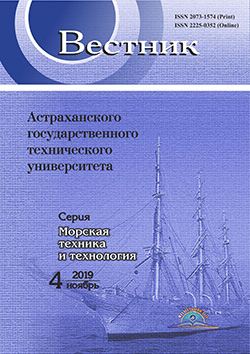Astrakhan State Technical University (Head of the Department of Physics)
Russian Federation
Russian Federation
CSCSTI 44.31
CSCSTI 45.01
CSCSTI 55.42
CSCSTI 55.45
CSCSTI 73.34
The article highlights the process of organizing the internal combustion engines operation, which is intended to raise the environmental safety and the extent to which the thermal energy of the working fluid is used in order to increase the energy efficiency and environmental safety of marine, fixed and transport engines. Today in propulsion engineering the process of supplying heat to the cycle (fuel injection, mixture formation, combustion) has been comprehensively studied and improved. The analysis of the thermodynamic cycle has been presented. Disadvantages of the working process (from the position of converting the chemical energy of fuel into mechanical energy) of a reciprocating engine with a crank mechanism are listed: incomplete combustion of fuel, loss of heat with exhaust gases and coolant, mechanical losses in the engine, etc. It has been found that the complete conversion of the thermal energy of the working fluid into mechanical work is impossible due to a short expansion stroke. The possibilities of increasing the efficiency of the working cycle of internal combustion engines are considered. An additional increase of the internal energy of the working fluid obtained by reducing losses in the cooling system due to the thermal insulation of the cylinder goes into increased losses with exhaust gases. It is proposed to introduce water into the cylinder after reaching the maximum temperature of the cycle, which helps lower the temperature of the gases, reduce the temperature difference and the intensity of heat transfer. It has been suggested to conduct tests with different moments of water supply, which will determine the effect of water on the process of burning fuel. The necessity of calculating various situations has been justified, since the amount of water will be different. The calculated water injection at the end of the combustion process can simplify cleaning and increase the engine capacity without significant amplifications of its main elements.
energy efficiency, ecological safety, thermodynamic cycle, working process, heat energy, cylinder pressure, heat insulation
1. Konks G. A., Lashko V. A. Mirovoe sudovoe dizelestroenie. Koncepcii konstruirovaniya, analiz mezhdunarodnogo opyta [World ship diesel engineering. Design concepts, analysis of international experience]. Moscow, Mashinostroenie Publ., 2005. 512 p.
2. Voznickij I. V., Punda A. S. Sudovye dvigateli vnutrennego sgoraniya [Marine internal combustion en-gines]. Moscow, MorKniga Publ., 2008. 283 p.
3. Ter-Mkrtich'yan G. G. Dvigateli vnutrennego sgoraniya s netradicionnymi rabochimi ciklami: uchebnoe posobie [Alternative Combustion Engines: Tutorial]. Moscow, MADI Publ., 2015. 80 p.
4. Hoang Koang Lyong. Povyshenie ekspluatacionnoj effektivnosti sudovogo DVS za schyot obosnovannogo vybora sposoba smeseobrazovaniya i komponovochnoj skhemy dvigatelya: dis. … kand. tekhn. nauk [Im-proving operational efficiency of marine ICE due to reasonable choice of method of mixture formation and layout of engine: diss. cand. tech. sci.]. Astrahan', 2017. 133 p.
5. Arhangel'skij V. M., Vihert M. M., Voinov A. N. i dr. Avtomobil'nye dvigateli [Car engines]. Pod redakciej M. S. Hovaha. Moscow, Mashinostroenie Publ., 1977. 591 p.
6. Cikl Atkinsona: kak eto rabotaet [Atkinson cycle: how it works]. Available at: https://auto.today/bok/1170-cikl-atkinsona.html (accessed: 04.10.2018).
7. D'yachenko N. H., Kostin A. K. i dr. Teoriya dvigatelej vnutrennego sgoraniya [Theory of internal combustion engines]. Pod redakciej N. H. D'yachenko. Leningrad, Mashinostroenie Publ., 1974. 552 p.
8. Semikin V. M. Analiz oblasti primeneniya zhidkostnoj nejtralizacii otrabotavshih gazov dizelej [Analysis of using liquid diesel exhaust gas aftertreatment]. Avtomobil'nyj transport, 2008, iss. 22, pp. 128-131.

















